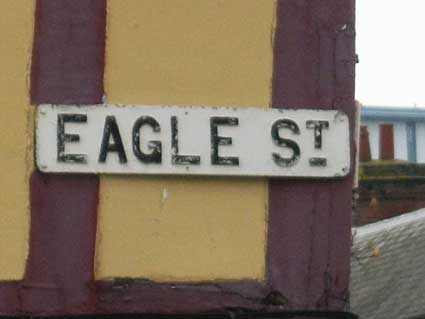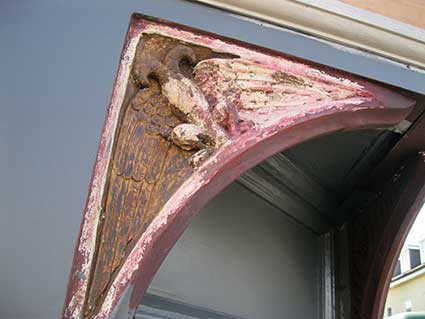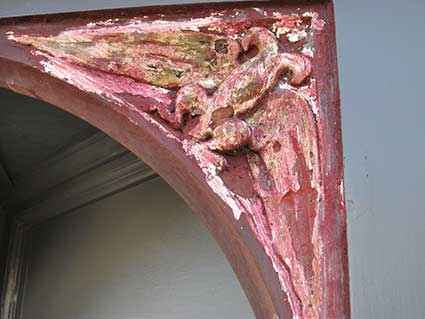The
Spread Eagle, the Eagle Street Ogre
1 to 3 Fore Street, corner of Eagle
Street
Street nameplates

 2014 images
2014 images
The Spread Eagle public house stands on the
corner of
Eagle Street (naturally) and Fore Street. The modern 'frosted' sign on
this Grade II Listed*** building states that this is the "oldest
tavern";
the Suffolk CAMRA site (see Links) dates it
to the 16th or 17th century ("The spread eagle was originally a Roman
sign and later used by many countries including Austria, Germany,
Russia, Spain & France. The sign is also used by many English noble
families. Its popularity as an inn sign owes a lot to the fact that it
was the device of Catherine of Aragon." See our Lady
Lane page for mention of Catherine of Arargon's visit to Ipswich in
1517.) The Old Bell over Stoke Bridge is also reputedly the oldest
pub in Ipswich, it is believed to date from the early 16th century and
was first recorded in 1639. The Spread Eagle is the last remaining
public
house of those which once stood on the four corners of this junction.
Photograph above right: to the right of the building with the spire in
the background is Lower Orwell Street.
***"A C16-C17 timber-framed and plastered building with exposed framing
on the upper storey with bracing from vertical member to vertical
member, a feature peculiar to East Anglia. The ground storey has been
underbuilt in brick. 2 storeys. 2 window range on the Fore Street front
and 2 window range on Eagle Street, casements with lattice leaded
lights. Roof tiled. The building has been restored and altered."
There is a Topal Tea vestigial sign in
Eagle Street.


The other face of the Spread Eagle carries
a cast
iron street nameplate with curved-section frame (unpainted), clamped
into place by the usual angled nails. If it wasn't for the superior 'T'
on this sign, we would all – given the tendency of humankind to
conflate and summarise in our minds – be referring to this street as
"FOREST'. "I'll see you at the top of Forest" might be a commonplace
phrase between Ipswich inhabitants.
Just opposite this street sign is
the site of the Martin & Newby
shop complex.
Fore Street, even though a modest length (and
disjointed), plays host to whole range of important historic
lettering: Meremayd, Fore Street Baths, Isaac Lord, The
Neptune Inn, the 1620 newsagent
and more.
See the Street name derivations page
for the source of the name.
The Ipswich Society exhibition and website
'The Fore Street Facelift 1961' tells much more of the street, its
surroundings and its history.

 2019 images
2019 images
Opposite the Spread Eagle is an unusual Ipswich Borough Council street
nameplate featuring the colour coat of arms
in a raised half circle above the street name. Looking at the shadow in
the painted brickwork, this clearly replaced a larger, older sign. See
our Felixstowe Road page for the
Levington Road street nameplate of a similar configuaration.
See
our Parliament Road page for the street
nameplate round the corner in Upper Orwell Street. There is an oval water hydrant medallion
to the left beneath the window-sill as a bonus (see Street furniture
for an explanation).
Corner entrance spandrels


These photographs of the spandrels on the corner entrance – now blocked
were taken on the Heritage Open Days in 2015. They were at the end of
another period refurbishment and paint makeover for the public house.
In fact the public house was open for the first time in some time,
despite some work being unfinished. The carvings show at above left
(Eagle Street side) the better-defined carving of a 'Spread Eagle' with
lion-like legs.
 2015 images
2015 images
The close-up shows more detail. It is thought that this area has
largely been left like this. There seems to have been a number of
layers of paint scraped off and possible a layer of gesso: the white
material which would cover up detail. The brown varnish appears to have
been applied recently.

This masonic double-headed eagle with chunky, splayed legs and
right-angled wings may have influenced the carving.
Compare with one of the spandrels on The Old
Neptune Inn.
11a/11 Eagle
Street and its Ogre (once Arthur
Thomas Mudd: Butcher's shop)

Above: 11a/11 Eagle Street comparison photographs (13 Eagle Street is
at the far right). The early 20th century image is courtesy of Richard
McCrae who, with his partner Ellie DeGory, now runs the EDRM
architectural
practice from 11a. The shop-front has changed somewhat at the left; the
butcher's premises are characterised by the grotesque moulding at the
upper right, just under the awning overhang. The modern view shows that
there have been changes to the facade with a timber door and doorcase
being reopened beneath the grotesque and the house front changed to a
shop. The two windows at the upper right (first floor level) are
largely unchanged. The bullocks in the left hand image were probably
assembled as a promotional photograph for the butcher's. However, Richard tells us that animals would have been
walked into Bond Street, through a side gate and down to an abbatoir
(which must have been quite small) behind the shop for despatch.
[UPDATE
28.11.2024: 'I was looking through a page on you site, noting the photo
of the butchers at 11/11a Eagle Street. For you information, the
business was owned by a one Arthur Thomas Mudd who is standing at the
rear of the bullock; his son Horace, wearing the apron, is at the front
of the animal. At the time, the business was one of the most successful
in Ipswich. Arthur also slaughtered the cattle in his own abattoir at
the rear of the shop. Arthur Mudd was the cousin of my grandfather.
Kind regards, David Mudd' Thanks
to David for assiduously researching his family history and adding
information here.]
David Mudd sends further research: ’Living in London as a child, my
parents told me that my Great Grandfather (John Arthur Mudd) ran a
butchers shop in Ipswich. In carrying out my first research in the
early 90s, I discovered that the whole Mudd family were involved in
butchery from the early 1840s through to mid c1960s. My 2 times Great
Grandfather (John Issac Mudd) seems to have started this trend
operating from a shop in the old Bell Lane, St. Peter's [in Over Stoke,
beside the pub of the same name}, previously setting up as a fruiterer
there c1838. According to 1861 census, John was a tenant farmer of a
'Lost Farm', the same almost certainly later known as Maiden Hall Farm,
which stood at the bottom of Oak Hill Lane, on what is now the Chantry
Estate at Over Stoke. John's two sons John Arthur and Thomas John Edgar
both carried on the family tradition, however both ran into
difficulties and bankruptcy at certain points of their business lives.
Thomas was predominantly a journeyman butcher travelling the country,
but it was his son, Arthur Thomas Mudd (born 1858) who was the very
successful one in business, starting at age 17 with a butchers shop in
the then old 'Provision Market' and by the age of 18 had himself the
shop on Eagle Street.
Other than Arthur Mudd of Eagle Street, my family had butcher shop
premises at:
48 Bell Lane;
Wherstead Road;
Small holding/market garden on corner of Wherstead Road/Croft St. – on
the same site of the old Stoke Green Windmill ]’Providence Mill’],
probably demolished in early to mid 1800s. [See our Windmills in
Ipswich pdf – the date of closure is given as late 1840s.];
Tacket Street c1868;
12 Bridge Street c1883;
7 Fore Street;
Side Gate Lane;
Stanley Houses, Derby Road;
Hawes Street;
54 Albion Street.
In 1948, when post-was rationing was still in force, The Evening Star published a column
called Under the Town Hall clock
by John Harkway. It featured an interview with Arthur Mudd who was 90
years old and living in Rushmere Road. “Amongst his treasures are a
number of photographs showing his shop-front. And if you really want to
realise how your meat ration compares with the quantity available in
the past you have only to look at these. The shop is literally
festooned with fowls, ducks, geese, turkeys and, of course, magnificent
sides of beef – enough, in fact, to arouse the envy of Mr. Strachey
[John Strachey, Minister of Food in the Attlee government]. Mr. Mudd
doubts whether the like will ever be seen again. – He also claims to be
the oldest living butcher and is unable to recollect another of his
trade reaching the same age.”
 Image
courtesy The Ipswich Society
Image
courtesy The Ipswich Society
The undated photograph of the Eagle Street Ogre on its keystone-shaped
base is from The Ipswich Society's Image Archive (see Links). The striking features are that the
butcher's shop awning overhang is still present; also that, directly
below the moulding, you can see a bricked-up doorway. The doorway of
no. 11 has since been opened up. There is a blue
plaque commemorating local historian John Glyde just next door at
no. 9 (the grotesque head is also shown on that page in a shot from
2004); that shop will be remembered by many as the Samaritans bookshop.
David Mudd contributes this: 'Over Mudd's shop which still stands in
Eagle
Street there is a gargoyle which is supposed to be the face of a tramp.
The story goes he lived in woods there and didn't want his woods built
on, but when they did build they had his face carved on the new
building. How much truth there is in this I do not know, but certainly
an interesting story.'
 2024 image
2024 image 
Above: the December
2024 image shows the ogre in pretty good condition, but the invasive
burglar alarm is unfortunate.
Interestingly and coincidentally, there is a grotesque head high up on
a former butcher's
shop facade at 39 Norwich Road. Both
faces emphasise distorted teeth – is there perhaps a tradition of
placing these features on butcher's shops? Perhaps it's merely a
coincidence confined to Ipswich. Some further research into the trades
operating from no. 11a Eagle Street will be of interest. The Public
Sculpture of Norfolk and Suffolk resource (see Links):
'A fearsome man, his red lipped mouth wide open to reveal fang-like
teeth, is set above the doorway of no. 11. It is difficult to
understand its function, a bit startling for a dentist, and if it was
intended to scare passers-by – why? Eagle street is a short narrow
street running east-west between Orwell and Bond streets. The house is
timber framed, but the present exterior probably dates from the 19th
century.'
Nos 9 and 11 are Listed Grade II but there is no mention of the Ogre...
'EAGLE STREET 1. 5379 Nos 9 and 11 TM 1644 SE 4/411 II GV The
description shall be amended to read: A timber-framed and plastered
building, C17 in 2 builds with C19 external features. 3 storeys. 4
window range, double-hung sashes with single vertical glazing bars in
the upper sashes. The ground storey has a small C19 shop front at No 9
and modern casements to No 11. Raised bands extend across the front
between the storeys. The ground storey is faced in brick (painted).
Roofs slate, hipped, with a modillion eaves cornice. No 11 has ground
floor plastered ceiling of lozenges within rectangle. 1st floor chamber
with ogee moulded plaster cornices, and lambs tongue stops to chamfered
axial beam. The list was previously amended in respect of this entry on
15 December 1977.
2. A timber-framed and plastered building with C19 external features. 3
storeys. 4 window range, double-hung sashes with single vertical
glazing bars in the upper sashes. The ground storey has a small C19
shop front at No 9 and modern casements to No 11. Raised bands extend
across the front between the storeys. The ground storey is faced in
brick (painted). Roofs slate, hipped, with a modillion eaves cornice.'
Home
Please email any comments
and contributions by clicking here.
Search Ipswich
Historic Lettering
©2004 Copyright
throughout the Ipswich
Historic Lettering site: Borin Van Loon
No reproduction of text or images without express written permission

 2014 images
2014 images


 2019 images
2019 images


 2015 images
2015 images

 Image
courtesy The Ipswich Society
Image
courtesy The Ipswich Society 2024 image
2024 image 